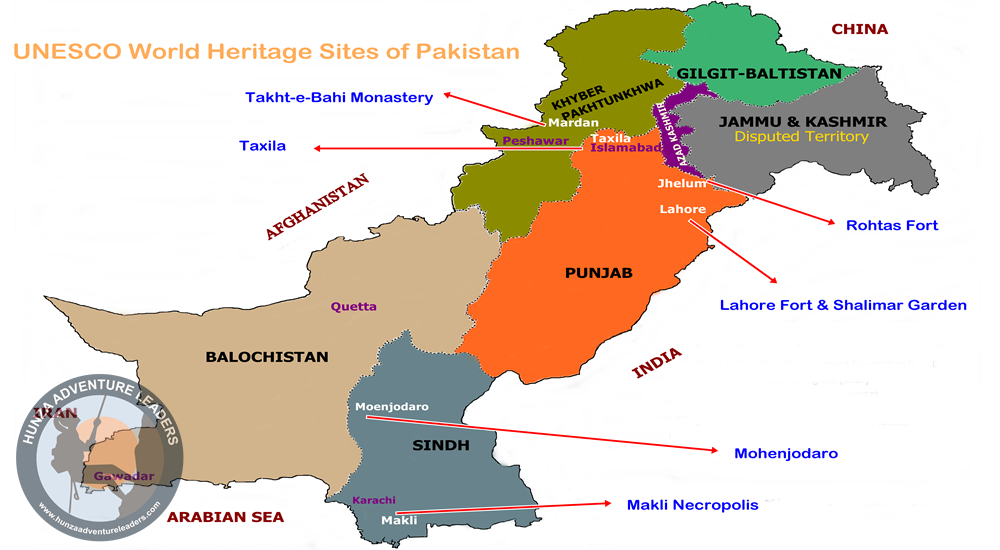Exploring Pakistan’s World Heritage Sites: A Journey into History and Culture
Pakistan is a treasure trove of cultural and historical marvels, boasting several UNESCO World Heritage Sites that stand as testaments to the country’s rich heritage. From ancient archaeological sites to architectural wonders, these remarkable sites offer a glimpse into Pakistan’s illustrious past. Let’s embark on a captivating journey as we explore some of Pakistan’s most renowned World Heritage Sites.
The Archaeological Ruins of Mohenjo-daro: A Window to an Ancient Civilization
Step back in time at the archaeological ruins of Mohenjo-daro, an extraordinary site that showcases the remnants of one of the world’s earliest urban settlements. Located in the Sindh province, Mohenjo-daro flourished around 2500 BCE, belonging to the enigmatic Indus Valley Civilization. Explore the well-preserved structures, intricate city planning, and artifacts that provide insights into the advanced lifestyle of its inhabitants. Mohenjo-daro is a living testament to the ancient roots of Pakistani civilization.
Lahore Fort and Shalimar Gardens: Architectural Marvels of the Mughal Era
Immerse yourself in the grandeur of the Mughal Empire by visiting the Lahore Fort and Shalimar Gardens in Lahore, the cultural heart of Pakistan. The Lahore Fort, a magnificent citadel, showcases a fusion of Mughal, Sikh, and British architectural influences. Explore its intricately designed palaces, pavilions, and mosques, marveling at the artistic mastery displayed in every corner. Adjacent to the fort lies the serene Shalimar Gardens, known for their stunning layout of terraces, fountains, and lush greenery. These UNESCO-listed sites are a testament to the grandeur of Mughal aesthetics.
The Buddhist Ruins of Takht-i-Bahi and Sahr-i-Bahlol: Tranquility Amidst Ancient Remains
Travel to the picturesque region of Khyber Pakhtunkhwa, where the Buddhist ruins of Takht-i-Bahi and Sahr-i-Bahlol transport you to the golden age of Buddhist civilization. Takht-i-Bahi, meaning “Throne of Origins,” is an intricately carved monastic complex perched on a hilltop. Wander through the courtyards, prayer halls, and stupas, experiencing the serene ambiance that still resonates within these ancient walls. Nearby, Sahr-i-Bahlol showcases the remains of a bustling ancient city, offering a glimpse into the daily life of its inhabitants. These sites are a testament to the influence of Buddhism in the region and its rich architectural heritage.
The Ruins of Taxila: Tracing the Footsteps of Ancient Learning
Located near Islamabad, the ruins of Taxila take you on a journey through time to the ancient center of learning and cultural exchange. This UNESCO World Heritage Site comprises several archaeological sites and museums that preserve the remnants of a once-thriving Gandhara civilization. Explore the monastic complexes, stupas, and educational institutions that flourished here, witnessing the fusion of Greek, Persian, and Indian influences. The ruins of Taxila offer a fascinating insight into the ancient world of academia and art.
Rohtas Fort: A Majestic Fortress Carved in Stone
Nestled amidst the picturesque landscape of Punjab, Pakistan, Rohtas Fort stands as a magnificent testament to the country’s rich history and architectural grandeur. This UNESCO World Heritage Site beckons travelers with its awe-inspiring walls, intricate design, and fascinating tales from the past. Also known as Qila Rohtas, Rohtas Fort, was constructed in the 16th century by the Afghan ruler Sher Shah Suri. The fort’s purpose was to serve as a stronghold and a symbol of power, strategically positioned to guard the region against external threats. Built with sandstone and reinforced with bastions and watchtowers, the fort showcases a blend of Islamic, Afghan, and Hindu architectural influences.
Makli Necropolis Thatta: A Vibrant History in Ruins
The Makli Necropolis is an ancient cemetery located in Thatta, Pakistan is considered one of the largest and most impressive necropolises in the world. The necropolis dates back to the 14th century and contains the tombs of numerous rulers, scholars, and Sufi saints. The necropolis stretches over an area of over 10 square kilometers and is home to approximately half a million tombs. The tombs are diverse in architectural style, ranging from simple stone structures to elaborate mausoleums adorned with intricate carvings and decorative motifs. The site holds great cultural and historical significance, as it reflects the architectural and artistic traditions of various dynasties that ruled the region over the centuries, including the Samma, Arghun, Tarkhan, and Mughal dynasties. The tombs at Makli Necropolis showcase a fusion of Islamic, Persian, and indigenous architectural styles.

